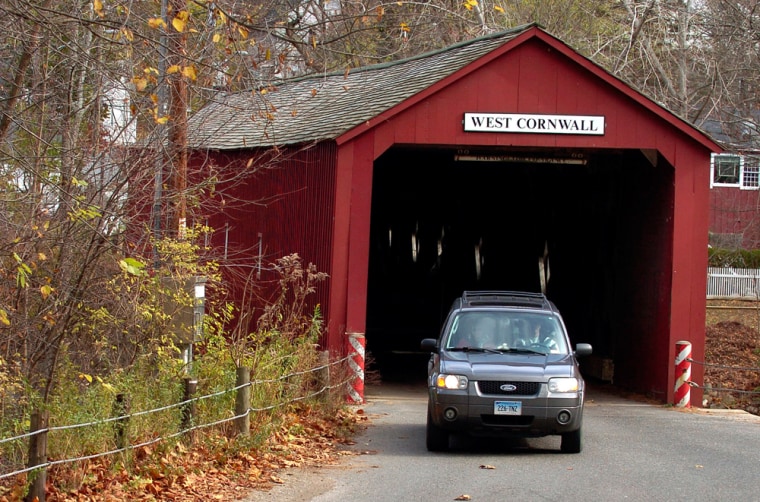The first thing visitors to the small hamlet of West Cornwall notice is its red covered bridge.
The timber structure commands attention, set against an idyllic backdrop of woods that line the banks of a gurgling Housatonic River.
Its wood creaks with each car crossing, reminiscent of a time when horse-drawn carriages, rather than SUVs, crossed its planks.
The bridge is one of three remaining covered bridges in Connecticut, a state where hundreds once existed. Another is southeast of the West Cornwall Bridge, while the third is in central Connecticut.
Covered bridges were once indispensable to American communities, numbering in the thousands. They connected towns and villages, enabling people to better communicate and exchange goods and services.
Today, the 800 or fewer around the country are no longer vital connectors. Instead, they've become hollow relics visited by travelers looking for a respite from the world's web of steel and concrete.
But a closer look at any one of the covered bridges across the country, with the most in Pennsylvania, tells a story of each area.
West Cornwall Bridge, in the northwest corner of Connecticut, was built in 1864 to connect two sleepy, rural communities -- Sharon and Cornwall. Prior to the bridge, a ferry was used to cross the Housatonic River to Sharon, according to the Cornwall Historical Society's Web site.
The one-lane bridge sits over the river along Route 128, where visitors come to wander the village for Shaker furniture or local pottery.
It uses a revolutionary lattice truss design that allowed builders to make longer, stronger spans. Ithiel Town, a Connecticut architect and bridge engineer, patented the design, which has been used widely across the nation.
The design was also used for Bull's Bridge in Kent, about 14 miles southeast of West Cornwall on Route 7. The bridge is the only other covered bridge in Connecticut that carries car traffic. It was built as a result of the burgeoning iron industry in northwestern Connecticut during the 18th and 19th centuries. The iron ore in Connecticut was used to build railroad car wheels and helped fuel the American Revolutionary War.
Local historians say the bridge was constructed by Jacob Bull, the owner of an iron furnace and saw mill, and his son, Isaac, in 1760, so wagons could get across the Housatonic River to haul pig iron from his foundry to Poughkeepsie, N.Y. His saw mill and furnace provided the timber and hardware to build the bridge, which became part of a major highway from Hartford to Newburgh, N.Y., used by the likes of George Washington, according to the town of Kent's Web site.
The bridge was one of several built across the gorge over the years as flooding and ice took their toll. The present bridge was built in 1842 and has become a tourist stop along scenic Route 7 as well as a starting point for hikers traversing a leg of the 52-mile Appalachian Trail through Connecticut.
Looking across to East Hampton in central Connecticut is Comstock Bridge, which is situated in a public park over the Salmon River, just north of Route 16. It's the only pedestrian bridge of the three and once connected the main road between East Hampton and Colchester when it was built in 1873, according to the town of East Hampton's Web site.
Today, the area serves as a fishing hole and picnic area. The bridge was renovated in the 1930s, when wooden gates and siding were added, and again in the 1970s, when steel plates were integrated to reinforce parts of the bridge. Inside, engineers used a Howe truss, a design widely used in railroad construction and for highway bridges.
Several factors including fire, flood and wind led to the demise of covered bridges by the beginning of World War I, said David Wright, President of the National Society for the Preservation of Covered Bridges.
Wright said covered bridges also became obsolete with newer technology and designs.
"As populations increased and traffic increased, some of the bridges that were built for light loads became structurally inadequate," Wright said.
Still, their rustic charms are not lost to visitors like Ken Murray, 60, who spent a few minutes marveling at the engineering of the West Cornwall Bridge on a Friday afternoon. The Nova Scotia resident, traveling through to Massachusetts with his wife, enjoys visiting covered bridges -- wherever he can still find them.
